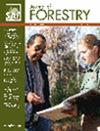阿巴拉契亚山脉分水岭伐木区溪边管理区实施十年来溪边相关鸣禽的反应
IF 1.8
3区 农林科学
Q2 FORESTRY
引用次数: 0
摘要
溪边管理区(SMZ)是美国东部积极管理森林的规范组成部分,但各州对管理区的宽度和上层林木保留的要求却大相径庭。在流域尺度的采伐范围内,我们评估了阿巴拉契亚源头溪流附近三种与河岸相关的鸣禽(阿卡迪亚蝇鴷 Empidonax virescens、蓝头蝰 Vireo solitarius 和路易斯安那水鸟 Parkesia motacilla)的相对丰度,这些溪流接受了三种 SMZ 处理,代表了美国东部目前各州 SMZ 规定的范围。在采伐之前,所有物种在所有类型的溪流(包括短流)附近都比较丰富。在采伐后 3 年和 10 年,所有物种在 SMZ 处理中的丰度基本相似,而在 100 米范围内残余树冠覆盖率较高的溪流沿岸,所有物种的丰度都较高。根据现行法规规定的森林 SMZ 可使这些物种在采伐后 10 年的管理林中得以生存,但丰度似乎主要受邻近林分中树冠覆盖率的影响。在采伐流域管理与河岸相关的鸣禽栖息地需要将关注范围扩大到当地溪流走廊以外,包括考虑在周围森林中保留更多树冠覆盖物的造林系统。如果保护与河岸相关的鸣禽是一项管理目标,则 SMZ 保护范围应扩大到所有溪流。研究意义。本研究的结果表明,肯塔基州和美国东部其他州的当代最佳管理实践(BMP)所规定的森林溪边管理区(SMZ)可在采伐后 10 年内维持管理流域中三种与河岸相关的鸣禽的类似丰度。在美国东部,沿多年生和间歇性溪流的 SMZ 中保留上层林木的做法很普遍,但各州的 BMP 很少要求保留沿短暂溪流的林木。目标鸣禽物种在采伐前占据了所有溪流类型沿岸的森林,其采伐后的丰度与溪流 100 米范围内的冠层保留呈正相关。如果河岸相关鸣禽长期占据受管理林分是一个目标,我们建议在所有溪流(包括瞬息溪流)周围使用 SMZ,并在溪流 100 米范围内实施至少中等保留率的造林系统。本文章由计算机程序翻译,如有差异,请以英文原文为准。
Ten-Year Response of Riparian-Associated Songbirds to Implementation of Streamside Management Zones in Watershed-Scale Harvests in the Appalachian Mountains
Streamside management zones (SMZs) are regulated components of actively managed forests in the eastern United States, but width and overstory retention requirements vary widely among states. Within watershed-scale harvests, we evaluated the relative abundances of three riparian-associated songbirds (Acadian flycatcher, Empidonax virescens; blue-headed vireo, Vireo solitarius; and Louisiana waterthrush, Parkesia motacilla) near Appalachian headwater streams receiving three SMZ treatments representative of a range of current state SMZ regulations in the eastern United States. Prior to harvest, all species were relatively abundant near all stream types, including ephemerals. Abundances of all species were largely similar among SMZ treatments at 3 years and 10 years postharvest and were higher along streams with greater residual canopy cover within 100 m. Forested SMZs as prescribed by current regulations can sustain these species in managed forests up to 10 years postharvest, but abundance appears to be driven largely by canopy cover retention in adjacent stands. Managing habitat for riparian-associated songbirds in harvested watersheds will require expanding the extent of focus beyond the local stream corridor to include consideration of silvicultural systems that retain greater canopy cover in surrounding forests. Where conservation of riparian-associated songbirds is a management objective, SMZ protection should be extended to all streams. Study Implications. The results of this study suggest that forested streamside management zones (SMZs) mandated by contemporary best management practices (BMPs) in Kentucky and other eastern US states can sustain similar abundances of three riparian-associated songbirds in managed watersheds up to 10 years after harvest. Overstory retention in SMZs along perennial and intermittent streams is common across the eastern United States, but state BMPs rarely require retention along ephemeral streams. Target songbird species occupied forests along all stream types prior to harvest, and their postharvest abundances were positively associated with canopy retention within 100 m of streams. If long-term occupancy of managed stands by riparian-associated songbirds is an objective, we recommend using SMZs around all streams, including ephemerals, and implementing at least moderate-retention silvicultural systems in areas within 100 m of streams.
求助全文
通过发布文献求助,成功后即可免费获取论文全文。
去求助
来源期刊

Journal of Forestry
农林科学-林学
CiteScore
4.90
自引率
8.70%
发文量
45
审稿时长
>24 weeks
期刊介绍:
The Journal of Forestry is the most widely circulated scholarly forestry journal in the world. In print since 1902, the mission of the Journal of Forestry is to advance the profession of forestry by keeping forest management professionals informed about significant developments and ideas in the many facets of forestry. The Journal is published bimonthly: January, March, May, July, September, and November.
 求助内容:
求助内容: 应助结果提醒方式:
应助结果提醒方式:


